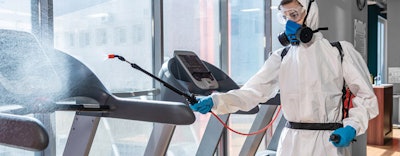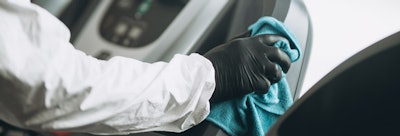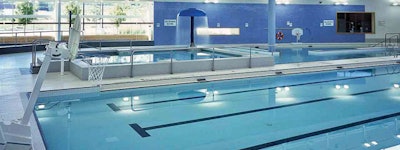
Modern fitness facilities have spent years politely asking customers to wipe down their equipment before and after each use. Many gyms have placed wipes, towels or sprays around the room, along with signage encouraging the use of cleaning equipment. The COVID-19 pandemic has taken away all casual prompts, however, as fitness facilities must meet health and safety guidelines in order to operate during the pandemic.
It's no longer just signs. The heightened awareness of cleanliness has led facilities to cap attendance, require masks and enforce physical distancing, but it has also led to an increased use of cleaning and sanitizing products. Individuals and operators are more aware of what's around them, and whether the customers, equipment, floor and air are clean.
"The biggest challenge over keeping facilities clean is that for the most part you can't see what you're fighting against," according to a representative of Synexis, a company pioneering microbial reduction in occupied spaces.
The following products and cleaning methods are helping people feel comfortable working out during an uncertain time.
Customer health
The United States' pandemic response has typically revolved around people — encouraging them to stay isolated from others or to keep their distance when they can't. Therefore, fitness facilities shut down in March, at a time when little was known about COVID-19 or how it might spread. How do you know if someone's infected? Where have people been? Who have they been interacting with? How easily does the virus jump between people? Is it airborne? How long does it stay on surfaces?
The answers to those questions have changed over the course of the pandemic. However, fitness facilities that have reopened have done so with the same goal in mind: to do whatever they can to ensure customers feel safe in their gym.
That puts the focus on individual hygiene. Facility operators can't control what goes on in customers' personal lives, but they can prepare their gym in a way that limits the impact of customers' decisions on the community.
While operators have been spreading out equipment, holding outdoor classes, requiring masks and limiting the number of people working out at a time, there's always going to be some level of interaction between individuals and the people and surfaces around them.
Kogniz, a health response platform, does the work ahead of time, using temperature screening technology to try to detect infected individuals as they enter a facility. Kogniz's artificial intelligence continuously tracks fevers, identifies exposure risks, and enforces health and safety protocols. If a customer or employee has a fever or fails to follow guidelines, Kogniz can send an automatic alert to managers. The system then identifies areas of the facility that require sanitization.
Kogniz can accurately read individuals' temperatures up to 16 feet away, while a single Kogniz Health Cam can support tens of thousands of readings per hour at a temperature accuracy of plus or minus 0.5 degrees Celsius. The Kogniz Health Cam accomplishes this through a microbolometer — an array of heat-detecting sensors that are sensitive to infrared radiation. When bolometers increase in temperature, their electrical resistance changes, and Kogniz converts this change into temperature values. Kogniz continuously normalizes readings so that temperature readings reflect body temperatures rather than skin temperatures that could rise and fall throughout the workout.
Once individuals are working out, companies like CloroxPro come into play. Two products — Clorox Commercial Solutions® Clorox® Disinfecting Wipes and Clorox® Germicidal Bleach — have EPA-registered kill claims against SARS-CoV-2, the virus that causes COVID-19.
"Our wipes kill SARS-CoV-2 in just 30 seconds and are a great option for disinfecting high-touch surfaces, including training tables and shared equipment," according to a CloroxPro representative. "We are also in the process of testing a number of our other disinfecting products across our professional product portfolio.
"Many of our products can be used against SARS-CoV-2 because they have an emerging viral pathogens claim."
While CloroxPro has long sold products that help protect against viruses and bacteria, the company also changed gears a bit since the pandemic. Clorox created a 55-gallon bleach drum suitable for cleaning up to 14,000 hospital rooms and delivered them to large healthcare facilities in the U.S. The increased demand for cleaning materials also led Clorox to open its manufacturing facilities 24/7 in order to maximize the supply of disinfectants that can help fight COVID-19. The company has made one million packages of wipes per day since January.
Equipment cleanliness
Wipes and disinfecting sprays can only be effective if they get used. GymValet, which was founded in 2006 by Dr. Bruce Sherman, attempts to increase the level of use by allowing facility operators to attach spray bottles and towels directly to strength training and cardio equipment.
"The sanitizing solution should be sprayed/applied to cover the full surface of the body-contacted parts of the equipment, left to sit for at least 10 seconds, and then wiped off," the GymValet website notes. "It is incumbent on fitness center owners and managers to optimize/maximize the possibility that regular equipment cleaning is achieved; give the human cleaners — members and/or staff — the best chance to sanitize the equipment by placing the cleaning supplies in direct proximity of the equipment. Every extra step that the human has to take to access the sanitizing supplies minimizes the chance that the equipment can or will be cleaned before and after use."
GymValet's website also notes that, while COVID-19 is an "enveloped" virus that sticks to surfaces, that also enables it to be killed by disinfectants that break down viruses chemically.
Similarly, CleanSpray Technologies' mission is to "use science and technology to provide efficient and effective methods for mitigating human exposure to harmful pathogens by cleaning the air we breathe, and the surfaces we touch."
CleanSpray's Bioesque™ Botanical Disinfectant Solution is a one-step cleaner that protects equipment against bacteria, viruses, tuberculosis and fungi.

Safe surfaces
Cleaning fitness facilities goes beyond the workout equipment. There may be pools, floors, walls or bathrooms that require attention, too.
Ramuc's Clean & Prep Solution removes all oils, debris and contaminants that form on those larger surfaces — from painted surfaces to plaster, concrete, gunite or fiberglass. The use of this product on pool surfaces before closing aquatic facilities ensures that the pool walls will be ready upon reopening.
Allied BioScience has developed antimicrobial-coating biotechnology that works 24/7. Needing just a single application to continuously protect surfaces, Allied BioScience's SurfaceWise™ coating has been approved by the EPA for use against COVID-19. The SurfaceWise™ non-toxic coating is applied via an electrostatic spray, with one gallon covering 4,000 square feet. Therefore, no matter how many times people touch a surface throughout the day, SurfaceWise™ will keep it disinfected.
Similarly, the Clorox® Total 360® Electrostatic Sprayer System leverages electrostatic technology to coat hard-to-reach surfaces with Clorox® disinfecting solution.
Air quality
A facilities' cleanliness also depends on the air flowing through it. Synexis® LLC, founded by Jim Lee in 2001 as a direct response to a New York City project in the wake of the Sept. 11 tragedy, attempts to keep air clean by using a patented technology that takes oxygen and humidity from the air to create hydrogen peroxide gas or dry hydrogen peroxide (DHP™).
"Wherever air goes in an indoor facility, so too will DHP to safely reduce the presence of viruses, bacteria, mold, odors and insects," Synexis representatives say. "The Synexis® system is UL-certified to produce no ozone and works continuously without disruptions or changes in workflow.
"We designed Synexis® to be a safe, environmentally friendly system that provides continuous protection without disturbing normal work operations or workflow. Hydrogen peroxide is a natural component of human lung chemistry. And our DHP exists at concentrations well below those naturally maintained inside the lungs."
Once the Synexis® BioDefense System is installed, it works 24/7 in an attempt to ensure a building's occupants feel comfortable in the space.
WellAware has developed a way to remotely monitor air purification. The company states that PureAware™ uses four-layer filters to destroy up to 99.98 percent of airborne viruses, and filter 99.97 percent of PM0.3 particulate matter. Users can also customize their service for their space, as the PureAware Pro provides two times the airflow, and the PureAware Compact is intended for smaller spaces.
PureAware's mobile app also allows customers to scan a QR code to see filter status and air quality before entering a facility. That level of knowledge and comfort will be essential in returning businesses to pre-pandemic levels of use. WellAware automatically sends a new filter when it detects a replacement is needed.
Not going anywhere
While the race toward cleaner facilities has been accelerated by COVID-19, those within the industry don't expect the focus on sanitization to go anywhere.
"We do anticipate the focus on clean facilities to last after the current pandemic is over," Clorox representatives say. "The COVID-19 pandemic has brought a renewed focus on 'cleaning for health' and will likely have long-lasting effects on human behavior and standards. The cleanliness and safety of shared environments is top of mind for many people, and we don't expect that to change in the near future. We take our role in helping protect public health seriously and our priority will remain as such."
|
Cleaning and maintaining closed facilitiesNo facility operators wanted to close due to COVID-19, but some were able to take advantage of time without customers present. How? By taking a look at how their operations could improve so that they operated safely and efficiently when customers were allowed to return. Clear Comfort president Steve Berens, whose company has spent much of 2020 working with Counsilman-Hunsaker to help provide information and leadership to aquatics facilities, says that "the playbook changed" during the pandemic. "What we've seen is there's a spectrum that we deal with on closings," Berens says. "Everything from just leave the pool running and don't mess with it, we're either letting people in or we're not, to what I call a hiatus. They keep everything ready to go and they open up rather quickly — it's a matter of getting their people back, but other than that they can get up and get going. And then a group is in hibernation mode. They're hibernating their pool, so they're shutting down." Berens and Clear Comfort, a leader in advanced oxidation processes technology, believe that the best way to utilize a forced closure is by improving parts of facilities that have been neglected. "Right now, where we're at is, how do we close smartly? How do we get ahead of the curve?" Berens says. "We've seen this iteration a couple of times, let's get ahead of it. Let's close smart. Let's reduce our chemical exposure in our facilities while we're closed. Let's create a more energy-efficient facility if it's not going to be open. Let's do the things we need to do to make closing a smarter activity, and take advantage of it. What are the things you can do to fix things so that it's better when you reopen?" Operators can also use their time to work with companies like ChlorKing® to convert their facilities from a chlorinated pool to a salt chlorination-based saltwater pool. Berens says that, even when businesses return to normal, customers' heightened awareness is going to ensure that answers like "that's the way a pool smells" aren't going to be suitable anymore. "Properly treated water is like swimming in hand sanitizer, essentially," Berens says. "So, for us, it's focusing on, how do you go above and beyond focusing on the entire facility? Help them understand this is part of a bigger spectrum that we have to deal with now in terms of sanitation than we dealt with before. But we do it the same way. How do we keep people safe? How do we do that from in the water? From in the air? From on the surfaces?" Clear Comfort focuses on the water and the air, using an advanced oxidation pool treatment to destroy contaminants while also helping cycle fresh air into the facility. "Our systems work 24/7," Berens says. "If you're doing the right kind of water treatment, especially with advanced oxidation, our advanced oxidation doesn't put a corrosive material like ozone in the water. It actually is a faster-acting thing, so it does everything in the pipe. We just treat with air, so it's environmentally-friendly. "We take care of the air and water, and then the surfaces become a lot easier." It's not just aquatics facilities that have been learning how to best operate while closed. Maple Flooring Manufacturers Association executive vice-president Dan Heney said this spring that it isn't detrimental to have gyms empty for long periods of times. However, there are ways to ensure the facility is operating at its best. MFMA recommends maintaining an environment that is 35 to 50 percent relative humidity and between 55 and 75 degrees Fahrenheit. Heney says the most important part of maintaining a healthy gym floor is staying within a 15 percent fluctuation in indoor relative humidity. "It really just depends on what schools are doing," Heney says. "Schools maintain their environments differently from when they're occupied to unoccupied. Most of the time, I've seen that if the school is unoccupied, they set back the HVAC system, and that can be detrimental to the floor." It remains to be seen whether the impact of the COVID-19 pandemic will lead facilities to shut down more frequently moving forward. "In the normal mode of operations, usually a facility pool would close down at least a week to do some maintenance and repairs," Berens says. "A lot of times they did that in holiday periods when the pool wasn't being used, or slow periods or whatever. Those things were normal practice. Will they do it two or three times more? Maybe. "I think we're going to have at least one more summer of uncertainty, and interruption. We're trying to help people by making them adaptable. By sharing information, by educating and doing these things that actually help them not get an answer but get ready to deploy the answer they have right now — and be ready to change it again. I think that's really key. Don't expect change to stop." |
This article originally appeared in the October 2020 issue of Athletic Business with the title "Sanitization products for facilities operating during the pandemic." Athletic Business is a free magazine for professionals in the athletic, fitness and recreation industry. Click here to subscribe.






































